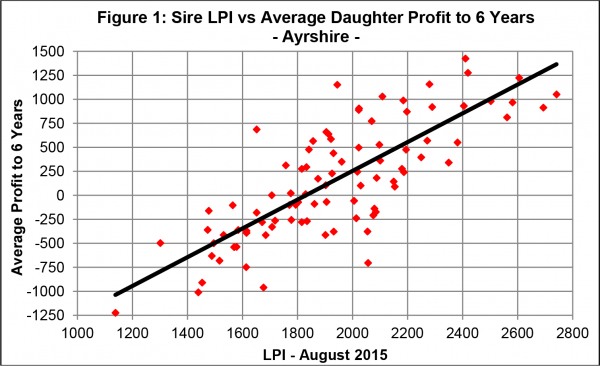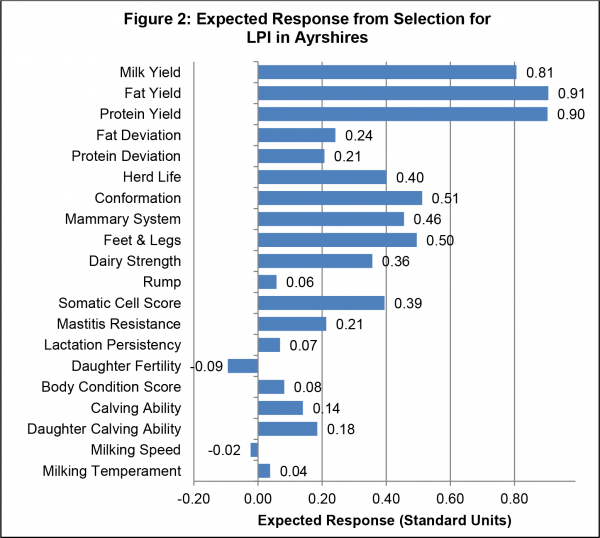The recent genetic evaluation release in August marked the introduction of a new formula for the Lifetime Performance Index (LPI) in each breed as well as the new Pro$ (Pro Dollars) index for the Holstein and Jersey breeds. If Pro$ is the ideal profit-based genetic selection index, how come it wasn’t introduced for Ayrshires as well? This decision was made over the course of multiple meetings during the past few years involving the Ayrshire Canada Breed Improvement Committee and Canadian Dairy Network (CDN). The bottom line is that the new LPI formula for the Ayrshire breed has been specifically designed to mimic essentially the same result as if Pro$ had been implemented. Let’s take a closer look.
Cow Profitability to 6 Years of Age
The extensive analysis carried out by CDN to develop Pro$ required the calculation of actual profitability values for cows in various breeds. For Ayrshires, accumulated profit over each cow’s lifetime until the age of six years was calculated for 17,400 cows born from 2005 to 2008. Cow profitability values were calculated based on the same economic parameters and equation used by Valacta and CanWest DHI for producing the Profitability Reports they provide to their clients on an annual basis. In addition to the heifer rearing costs from birth to first calving, the income generated from milk sales, as well as the associated expenses, were estimated based on each cow’s production performance accumulated during each lactation until reaching six years of age. For cows that left the herd before this age, the revenue and expenses accumulated to the age at disposal determined the lifetime profit. Using profit accumulated to six years of age allows each cow the opportunity to express up to four cycles of reproduction, calving, health, functional conformation and production performance.
Sire LPI Versus Average Daughter Profit
Once individual cow profitability values were calculated, CDN examined the relationship between a sire’s LPI and the average accumulated profit to six years of age of their daughters. Figure 1 shows this relationship for the current LPI formula introduced for Ayrshires in August.

There are two main points demonstrated by this graph. Firstly, there is a strong correlation of 79% between a sire’s LPI in August 2015 and the realized average daughter profit to six years of age, based on the group of cows analyzed born from 2005 to 2008. This high degree of relationship indicates that LPI is currently an excellent indicator of the expected lifetime profit of an animal’s daughters. In fact, one might say this correlation is outstanding given the many nongenetic factors that can affect a cow’s lifetime profitability, especially herd management and other environmental influences.
Secondly, we can learn from this chart how to translate current LPI values for sires into expected differences in profit of their daughters. For Ayrshire sires, every 100-point increase in LPI translates to an extra average profit to six years of age of $150 per daughter! One way to look at this interpretation of LPI values is to compare the extra cost for a dose of semen for higher ranking LPI sires relative to the expected lifetime profit the daughters of the higher LPI sire will generate.
LPI Versus Pro$ in Ayrshires
During the course of developing Pro$, CDN applied the resulting equation to Ayrshires as well as the other dairy breeds in Canada. Given the strong relationship between LPI and the average daughter profit to six years of age, it was ultimately decided not to introduce a second national genetic selection index for Ayrshires. In fact, if Pro$ was introduced for the Ayrshire breed in August it would have a correlation of 98.7% with the published LPI values for proven sires. Stated in another way, only one of the current Top 20 LPI proven sires would not be among the top 20 if sorted by Pro$ and only minor reshuffling in their specific order would exist. Ayrshire breeders interested in making genetic selection decisions that target maximum profit from milk sales can use the current LPI rankings with confidence.
Expected Response from LPI Selection
One of the critical components of the educational campaign designed to communicate the new Pro$ to Holstein and Jersey breeders is the concept of “expected response” (Figure 2).

Basically, all traits of interest in dairy cattle improvement tend to be genetically correlated to each other to some extent. Some traits may be positively correlated, meaning that selection for one trait will lead to a correlated improvement in the second trait as well. For other traits that have an antagonistic genetic relationship, such as production yields and fertility, specific attention must be made to apply selection for both at the same time or else one will fall behind as the other improves. Therefore, to understand the genetic progress you can expect from selection using an index like LPI, the best tool is the expected response per trait as shown in Figure 2. Clearly, selection for LPI in Ayrshires will produce the highest gains for production yields but significant gains can also be expected for Herd Life, Conformation, Mammary System, Feet & Legs, Dairy Strength and Somatic Cell Score. For most other traits, some genetic gain is expected through selection purely for the new LPI. Two exceptions are Milking Speed and Daughter Fertility due to the negative correlations they have with other traits of importance. For example, in the Ayrshire breed, Daughter Fertility is negatively correlated with the major type traits in addition to the usual antagonistic relationship with production yields that is common to
all breeds. Therefore, with high importance placed on production and type improvement in the breed, it is difficult to also achieve genetic improvement for Daughter Fertility without significantly increasing the emphasis on this trait in the LPI formula. Fortunately, among the current list of high ranking LPI proven sires in the breed, several have above-average proofs for Daughter Fertility.
Summary
The primary goal of every dairy producer, regardless of breed, is profitability. In August 2015 the Holstein and Jersey breeds introduced Pro$ as a second selection index since it differed significantly from the LPI formula in those breeds. Ayrshire breeders can directly use LPI for genetic selection to maximize cow and herd profitability since it is 98.7% correlated to Pro$ if it had been introduced. Using LPI, every 100-point difference between Ayrshire sires translates to an average extra profit per daughter of $150 to six years of age. Expected response resulting from selection for LPI is favourable for essentially all traits of interest with significant gains achievable for the main production and conformation traits as well as resistance to mastitis and longevity.
Source: Canadian Dairy Network









